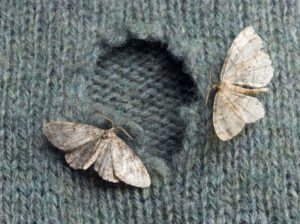Webbing and case-making clothes moths are the two types of moths that can plague wool, silk, cashmere, angora or fur, and other textile items that contain keratin.
 It is not actually the moths that eat your clothes, but their larvae, as moths only have mouths during their larval stage. A female moth deposits a mass of fertilized eggs, between 50 to 1,000, onto a piece of clothing.
It is not actually the moths that eat your clothes, but their larvae, as moths only have mouths during their larval stage. A female moth deposits a mass of fertilized eggs, between 50 to 1,000, onto a piece of clothing.
Moth larvae have a specific diet, and the female moths therefore typically pick clothes made from animal fibres. Moth larvae will sometimes eat leather, feathers and even hairballs of human or pet hair. Moth larvae won’t eat synthetic and cotton fabrics, unless they’re blended with an animal fibre. That’s because synthetic and cotton material doesn’t contain keratin.
Clothing moths prefer to live in dark places, like in a closet, where they can discreetly deposit their larvae onto the nearest suitable garment. They spin cases and emerge as a full-grown moth in 2 ½ weeks.
Cedar and lavender can be used as natural moth repellents.
How to keep your clothes safe from moths?
Protect your clothing by effectively treating and preventing moth infestations.
Locate the source of the infestation
The first step is to figure out where the moth infestation originated. Look for holes in any garments made of animal fibres, to try and find out where the moths have been leaving their eggs.
Clean your clothes
Items made of wool or animal products, must be taken to the dry cleaners. Let the dry cleaners know that you want the clothes cleaned specifically for moths, as they will use chemicals that will kill moth eggs.
Everything else must be placed in the washing machine and washed with hot water, this will ensure that all moth larvae are destroyed. Place your washed clothes in the sunlight, as this also helps to kill larvae.
Clean your closet
After the source has been found, and you have washed your clothes, you need to clean your closet. Moths’ eggs can end up in a whole host of places – floors, the tops and bottoms of shelves, and even the ceiling. Do a thorough job of vacuuming and dusting, especially in the corners and any carpeted areas. Moth eggs can hide in carpets and under furniture, so it’s very important that you vacuum everywhere.
Iron your clothes
By using an iron, which applies direct, high heat to your clothing, will kill moth eggs and larvae clinging to your clothes. It is perfectly safe to iron your wool clothing unless the garment’s tags say, “do not iron” or “dry clean only”. If the clothing item can be ironed, set your iron to the “wool” setting, use a steam heat, and press from the inside with a pressing cloth between the iron and your clothes.
Freeze your wool
Sub-zero temperatures will kill any larvae or moths in any of their developing stages. Place the affected items in the freezer for a few days, it isn’t necessary to pack the items in plastic bags.

